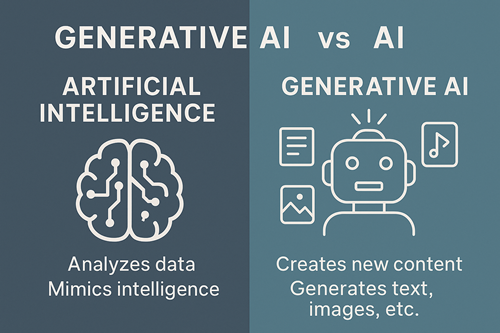Generative AI vs AI
The Creative Side of Artificial Intelligence Explained
You’ve probably heard the term Generative AI floating around in conversations, news headlines, or even your workplace. But what does it actually mean? Is it just another tech fad, or is it something that’s here to stay? Let’s break it down in a way that’s easy to understand.
What Is Generative AI?
Generative AI is a type of artificial intelligence that can create new content. Unlike traditional AI, which mostly analyzes data and makes predictions, Generative AI can produce original text, images, videos, music, and even computer code.
Generative AI in Simple Terms
Think of it like this:
-
Traditional AI = a calculator. It gives you answers based on what you put in.
-
Generative AI = a creative assistant. It takes what it has learned and produces something brand new.
Popular Generative AI Tools
Some of the most well-known Generative AI tools include ChatGPT, Google Gemini, DALL·E, and MidJourney.
MIT News explains it simply: Generative AI is designed to “generate outputs such as text, images, or code that resemble human-created work.”
Why Is Generative AI Important?
Generative AI isn’t just tech hype; it’s already transforming how we live and work.
Everyday Examples of Generative AI
-
For work: It can draft emails, build presentations, write blog posts, and even brainstorm ideas.
-
For business: Companies are using it to design ads, automate customer service, and personalize shopping experiences.
-
For everyday life: Generative AI shows up in things like auto-complete texts, AI chatbots, or apps that redesign your living room with a single photo.
According to McKinsey, Generative AI could add up to $4.4 trillion annually to the global economy. That’s a huge sign that this technology is not going away anytime soon.
Generative AI vs AI: Key Differences
It’s easy to mix up the terms AI and Generative AI, but they aren’t the same thing.
What AI Does Best (the Big Umbrella)
Artificial Intelligence (AI): A broad field that covers any system designed to mimic human intelligence. This includes chatbots, recommendation engines (like Netflix suggesting a movie), facial recognition, or predictive analytics.
What Makes Generative AI Unique (the Creative Tool in the Box)
Generative AI: A subset of AI that focuses specifically on creating new content. It doesn’t just analyze data; it produces original text, images, videos, or music that feels human-made.
Think of AI as the entire toolbox, and Generative AI as one specialized tool inside the box, the creative one.
IBM Research makes the distinction clear: while AI helps businesses analyze data and improve efficiency, Generative AI goes a step further by creating new content from what it has learned.
Benefits of Generative AI
Generative AI brings a lot of opportunities!
Saving Time and Boosting Productivity
It automates routine tasks like emails, data summaries, or first-draft content.
Unlocking Creativity for Individuals and Businesses
It helps spark new ideas when you’re stuck and gives small businesses access to tools once reserved for big companies.
Risks of Generative AI
Of course, it’s not perfect. There are some downsides to watch out for.
Accuracy and Bias Issues
It can produce wrong or misleading information, and because it learns from existing data, it can carry hidden biases.
Copyright and Ownership Concerns
Who “owns” content created by AI? That’s still being debated.
Forbes notes that while Generative AI is powerful, businesses need human oversight to avoid errors or ethical missteps.
Should You Care About Generative AI vs AI?
Absolutely. Even if you’re not in tech, Generative AI is already showing up in your life, and it will only grow. Understanding what it is and how it works will help you make better decisions, whether you’re running a business, working in an office, or just curious about the future.
Remember when people thought the internet was just a fad? Generative AI is having a similar moment, and it’s here to stay.
The Bottom Line on Generative AI
Generative AI isn’t just for tech experts, it’s for everyone. It’s a tool that can help with creativity, efficiency, and problem-solving, but it’s also one that comes with risks. By learning the basics now, you’ll be better prepared for the ways it’s going to shape our work and everyday life.
So next time someone mentions Generative AI, you won’t have to smile and nod. You’ll actually know what it means, and maybe even impress them with an example or two.
Frequently Asked Questions About Generative AI
What is Generative AI in simple terms?
Generative AI is a type of artificial intelligence that can create new things, like text, images, music, or code. Unlike regular AI, which mostly analyzes data, Generative AI produces original content.
What are some examples of Generative AI?
Popular examples include ChatGPT (text), DALL·E and MidJourney (images), and Google Gemini (search and productivity). These tools can write, design, or generate ideas in seconds.
How is Generative AI used in business?
Businesses use Generative AI to draft emails, write blog posts, create marketing visuals, generate code, and improve customer service. According to McKinsey, it could add trillions of dollars to the global economy each year.
What are the risks of Generative AI?
Generative AI can sometimes produce inaccurate or biased results. It also raises questions about originality and copyright. That’s why experts, including IBM Research, stress the importance of human oversight.
What is the difference between AI and Generative AI?
Artificial Intelligence (AI) is the broad term for all kinds of smart technology, such as recommendation engines, image recognition, or predictive analytics. Generative AI is a specific type of AI focused on creating new content, like text, images, or music. All Generative AI is AI, but not all AI is Generative AI.
If you want to see how Generative AI can help your business, get in touch with us for a no obligation chat.




